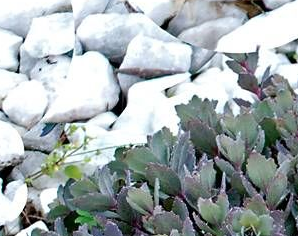Dazzleberry Sedum sometimes referred to as Sedum ‘Dazzleberry,’ is a succulent plant belonging to the Sedum genus. This plant is a hybrid that was developed by breeding Sedum ‘Autumn Joy’ with Sedum ‘Matrona. This plant is well-known for its low care requirements and its adaptability to a wide range of environments, from nutrient-poor soil to high temperatures and dryness. In the summer and fall, it bears clusters of pinkish-purple flowers, which are followed by seed heads that resemble red berries. The leaves normally have a green color, but in the autumn they can take on shades of bronze or purple. The drought-resistant perennial Dazzleberry Sedum can be used in a variety of settings, such as a ground cover, a border, or even a rock garden.
This multicolored series of Sedum is the result of Chris Hansen’s breeding efforts. Chris has spent several years hybridizing and conducting field trials in West Michigan, and after doing so, he has narrowed down his selection of cultivars for his SUNSPARKLER line to include only the very best and most distinctive cultivars.
Dazzleberry Sedum Size
‘Dazzleberry’ is a remarkable shrub with a variety of captivating qualities. At maturity, this groundcover sedum develops lovely mounds with spectacular smoky blue-gray foliage that grows to be 8 inches tall and 18 inches broad. Its huge clusters of raspberry-pink flowers, measuring 6 to 8 inches in diameter, bloom for more than seven weeks in the late summer. The blooming period begins earlier than the majority of commercially available fall-blooming sedum varieties.
Dazzleberry is a wonderful low-maintenance Sedum that spreads quickly and covers the landscape with a carpet of smoky blue-gray leaves and huge, dark raspberry flowers.
Dazzleberry Sedum Care
Groundcover sedum grows in sunny USDA Hardiness Zones 4–9. Although partial-sun settings are generally appropriate full-sun areas with dry soils produce the most vibrant foliage color. ‘Dazzleberry’ can be used as a cut flower, in mass plantings, along paths and borders, in pots, and rock gardens. In addition to this, they are resistant to animals such as rabbits and deer, who do not typically consume or damage them.
Sunsparkler ‘Dazzleberry’ is an excellent option for today’s perennial programs due to its compact growing habit and appealing succulent leaves, great performance in both containers and gardens, early fall blossoming, and extended bloom period. It thrives in arid environments and is a popular option for rock and alpine gardens, fire-scaping, and decorative borders and pots. Planting with Coreopsis, Asters, Yarrow, and other succulents are advised for a stunning show. It is essential to water the plant occasionally and, if desired, pinch the spring growth a bit to thicken the plant.
A well-drained, sunny, or partially shaded spot is ideal for planting. It can withstand dry conditions for long periods, but it still needs regular watering while it’s establishing itself and before it starts to bloom. Plants, however, need to dry out in between waterings.
Dazzleberry Sedum Blooming Time
Sedums are plants that require lengthy day durations and do not bloom when planted in short day lengths. When exposed to long days, or days with lengths greater than 14 hours, the plants often start to initiate the process of developing flower buds. Growers mostly offer photoperiodic illumination by extending the day duration to 16 hours or by utilizing a night interruption of four hours to encourage flowering during times of the year when the days are naturally short.
Temperature determines when plants bloom after the advent of lengthy day durations. At 68 degrees Fahrenheit, the blooming time for Sedum ‘Dazzleberry’ is about eight to nine weeks.
In late summer and autumn, its massive blooms fully cover the foliage. Its nectar-rich flowers are frequently visited by butterflies and other pollinators. This low-growing plant (just 6-8 inches tall) is ideal for sunny, dry areas. All Sedums, including Dazzleberry, prefer dry, sunny conditions where they can flourish without much care.
Dazzleberry Sedum Pruning
Sedum does not need extensive pruning other than the removal of diseased or broken stems. When growing sedums in cooler locations, it is beneficial to remove all of the plant parts that are dead throughout the winter so that there is room for fresh growth in the early spring.
The optimal timing to grow sedum is in the spring, after frost risk has passed but before the onset of summer heat. Sedum grows slowly on average, but this depends on the species and variety. During the growing season, no pruning is required. However, light pruning for shape, to eliminate any broken branches from shipment, or to thin down a densely branched plant mostly aids in the transplanting process and improves the appearance of the new planting.



